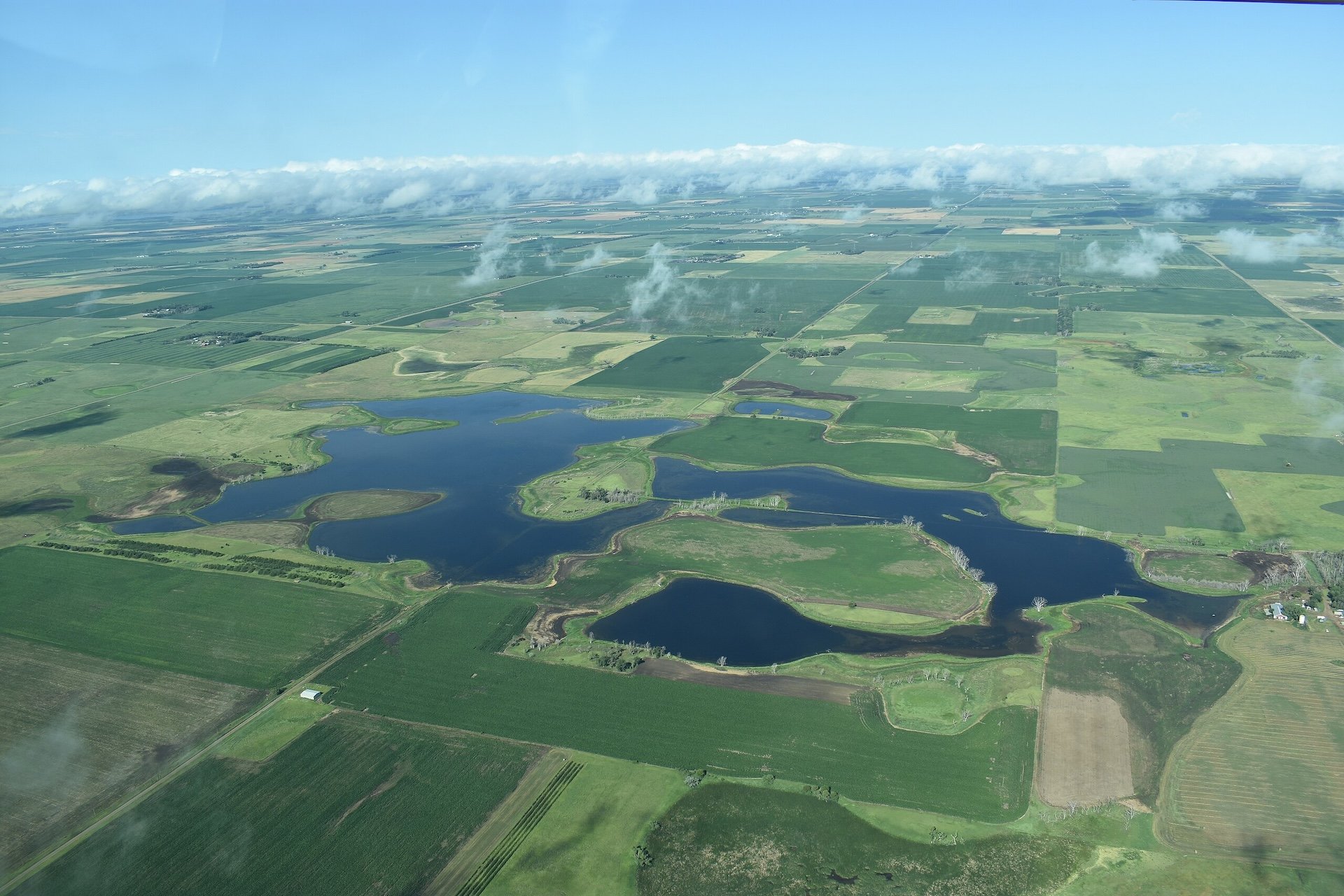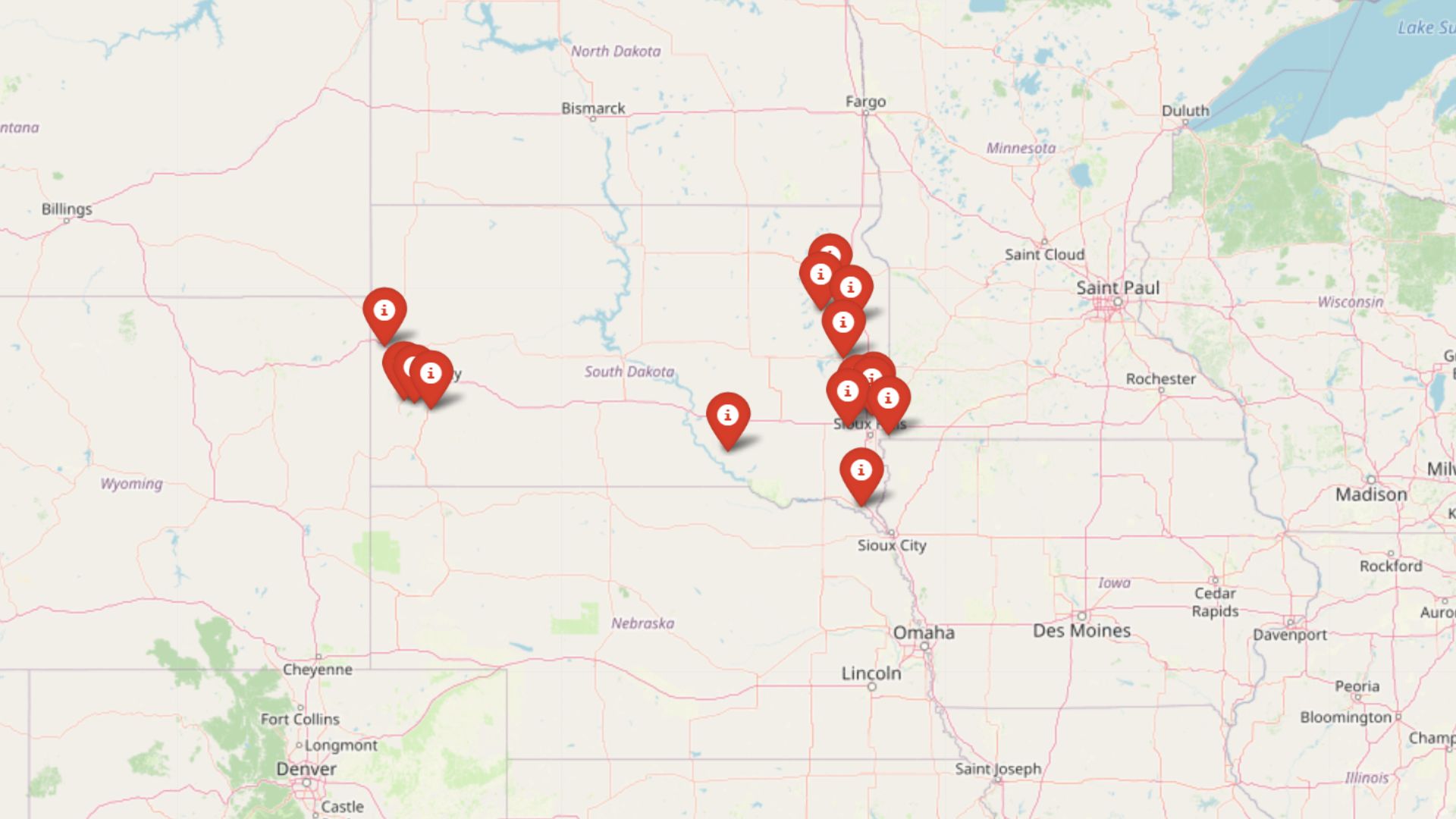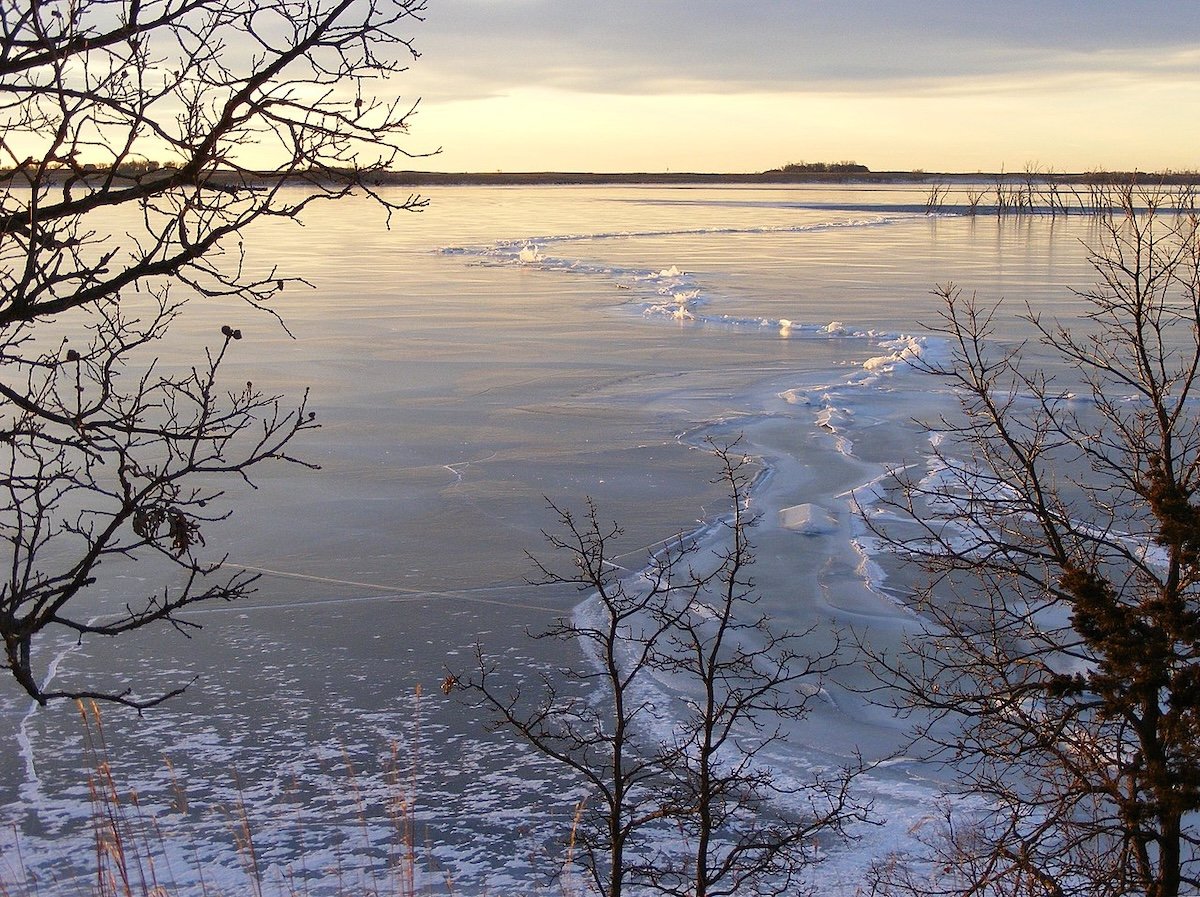
There’s something incredibly alluring about the peace and quiet of secluded places, and Western South Dakota is brimming with such hidden gems. I’ve always been fascinated by the small towns tucked away amid the rolling plains and rugged hills, where life moves at a different pace.
From vast prairies to dense forests, these towns offer a retreat from the bustle of modern life. Whether you’re seeking solitude, a close-knit community, or a deep connection with nature, these places have it all.
While the high-plains identity dominates the broad view—big sky, sparse settlement, tough shortgrass—the real hallmark of western South Dakota is its abrupt, scenic interruptions: Badlands spires, forested hills, and river canyons nested inside the prairie expanse. Those contrasts give each of the 25 towns we explore their own flavor of seclusion, whether it’s Flat Earth silence in Owanka or pine-scented stillness around Rochford.
25. Interior: Gateway to the Badlands’ Silence
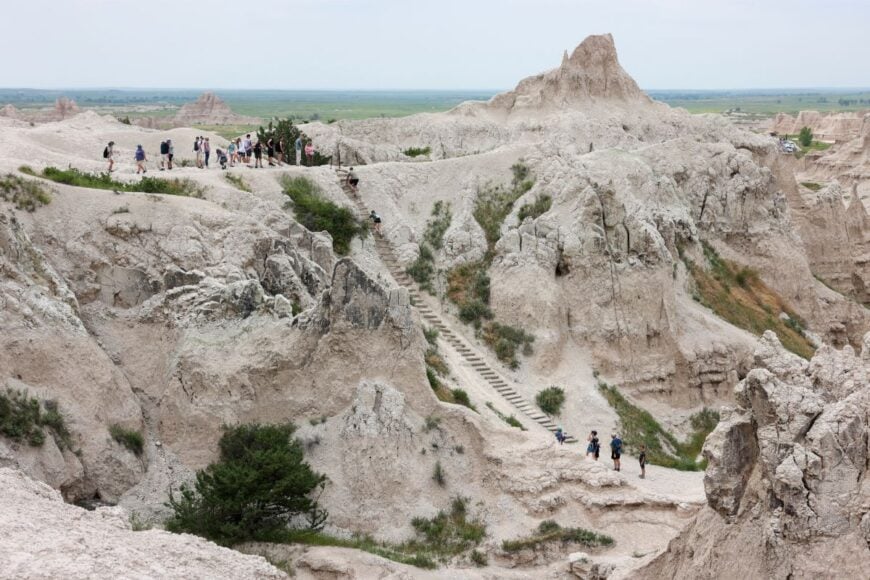
Interior, with fewer than 100 residents, is one of those towns where the vastness of the prairie meets the jagged edges of the Badlands. Its seclusion comes from its small size and the dramatic landscape that surrounds it, cutting it off from the outside world in both sight and sound.
The vibe is rustic and almost otherworldly, with weathered storefronts and a rhythm of life tied closely to the land. Visitors can wander into Badlands National Park just minutes away, explore old churches, or catch a rodeo at the community arena. Most locals are tied to ranching and tourism, living on the edge of two worlds—harsh prairie survival and the trickle of visiting travelers.
The sunsets here stretch endlessly, painting the spires and buttes in glowing orange. Interior feels like a place carved from the land itself, quiet and resilient.
Where is Interior?
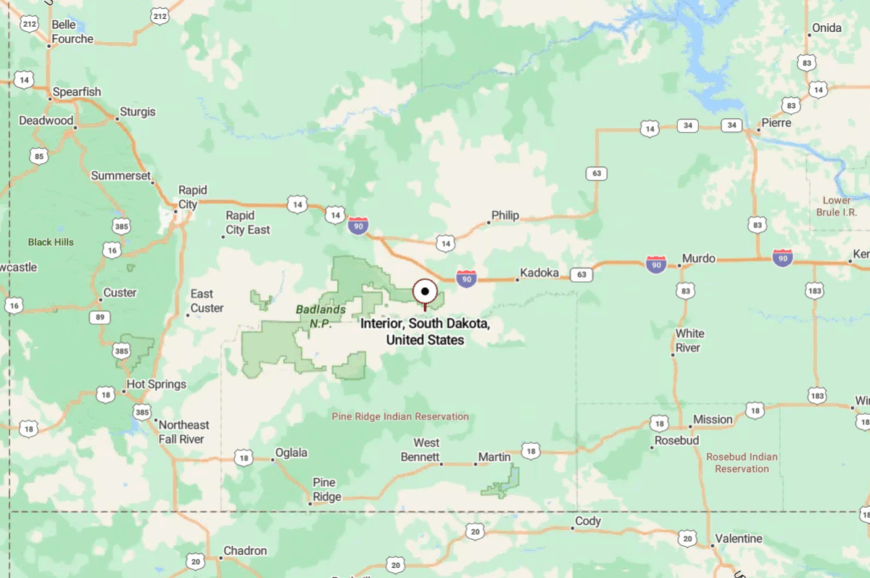
Interior lies in Jackson County, tucked into the southern edge of Badlands National Park. It’s about 50 miles southeast of Rapid City, reachable via Interstate 90 and then following State Highway 377.
The road carries you from grassland plains into a landscape of sharp cliffs and endless skies. By the time you arrive, it feels as though the rest of the world has melted into the horizon.
24. Hermosa: A Hidden Stop Near the Black Hills

Hermosa, with around 500 residents, is often overlooked by travelers heading to the Black Hills’ bigger attractions, which is exactly what makes it feel so secluded. The town vibe is quiet and down-to-earth, with a mix of ranch homes, small shops, and wide views of the prairie.
Its isolation comes from being nestled between rolling grasslands and the forested hills to the west, where the horizon always feels close. Things to do include visiting the nearby Custer State Park, exploring local diners, and enjoying the slower pace of small-town life.
Ranching and small businesses sustain the economy, creating a community grounded in the land. Hermosa is the kind of place where the stillness of the prairie hums louder than passing traffic.
Where is Hermosa?
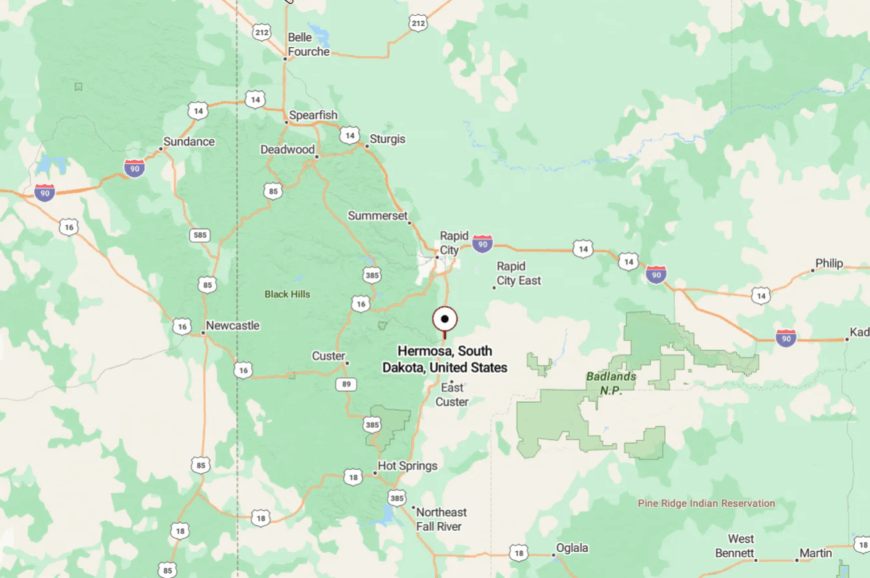
Hermosa is located in Custer County, about 20 miles south of Rapid City. It’s accessible via US Highway 79, a drive that quickly trades city noise for open grassland and pine-dotted hills.
The journey is straight and spacious, with long views in every direction. By the time you roll into town, the quiet has already taken hold.
23. New Underwood: Small Town on the Prairie Edge

New Underwood, with about 650 people, rests quietly on the edge of the prairie where ranchland stretches for miles. Its seclusion is felt in the wide skies above and the lack of urban intrusion, even though Interstate 90 hums nearby.
The town’s vibe is neighborly and practical, with community events, old grain elevators, and small shops shaping its character. Visitors might stop into a café, explore the nearby grasslands, or attend a rodeo at the local arena.
Farming and ranching remain the heart of its economy, anchoring daily life to the soil and seasons. Evenings bring a prairie hush that settles over the town like a blanket. New Underwood feels like a pause button pressed in the middle of wide-open country.
Where is New Underwood?
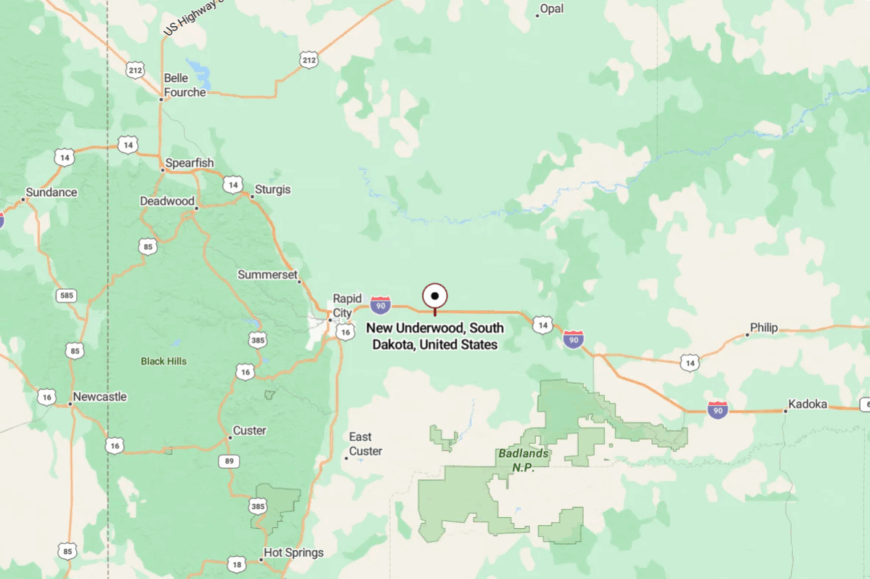
New Underwood is in Pennington County, about 20 miles east of Rapid City. It sits just south of Interstate 90, yet remains tucked away from the bustle of traffic.
To reach it, I exited the interstate and drove down a quiet main street where life slows to a crawl. The prairie surrounding it reinforces the sense that the outside world is far away.
22. Enning: Plains Solitude
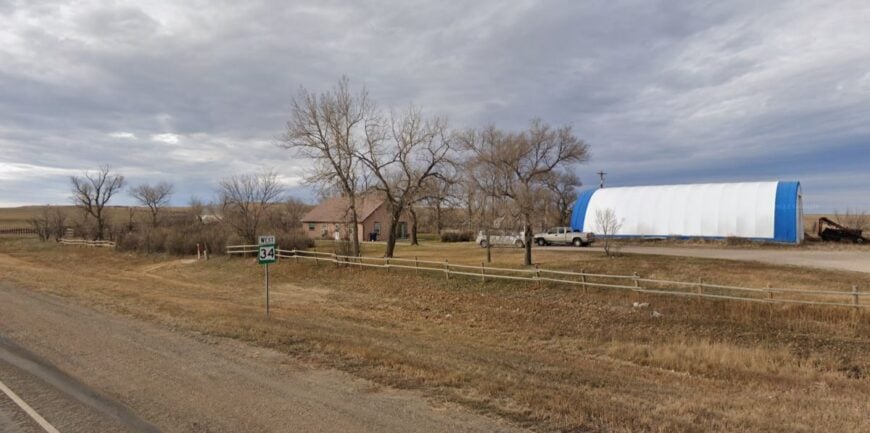
Enning is little more than a dot on the map, with its small post office, school, and scattering of homes. With fewer than 200 residents, it’s one of those places where silence is the rule rather than the exception.
The vibe is starkly rural, with dirt roads, wind-swept grass, and an almost eerie quietness that settles over the land. Ranching is the primary livelihood, and life is lived in close rhythm with the changing seasons.
Visitors passing through might spot prairie wildlife, visit a local rodeo ground, or simply stop to take in the immensity of the plains. The sheer openness here makes you feel both small and free. Enning is the kind of place that reminds you how vast the Great Plains really are.
Where is Enning?
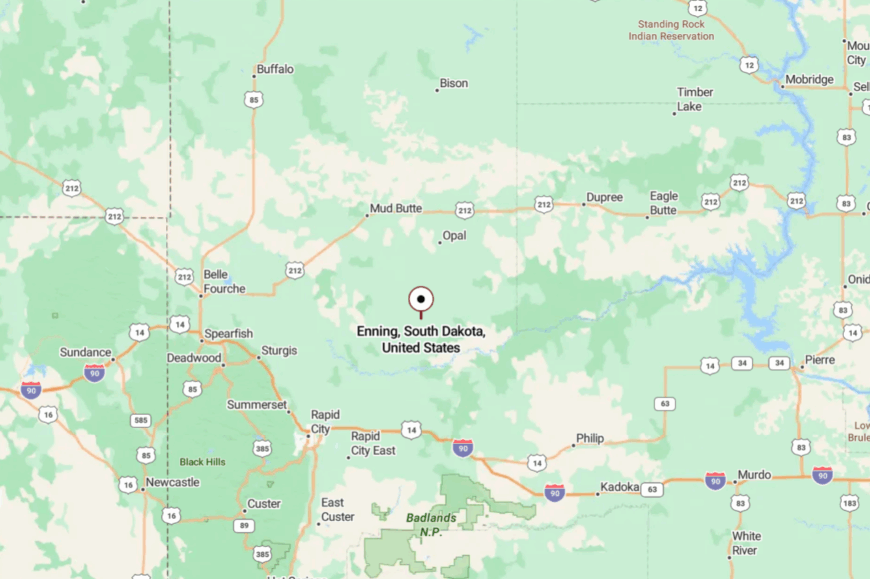
Enning is located in Meade County, northeast of Sturgis and well off major highways. It’s about 40 miles from Sturgis, reachable only by county roads.
The drive takes you through windswept prairie with almost no towns in between. Arriving feels like stepping into a landscape that refuses to be tamed.
21. Elm Springs: Windswept and Forgotten
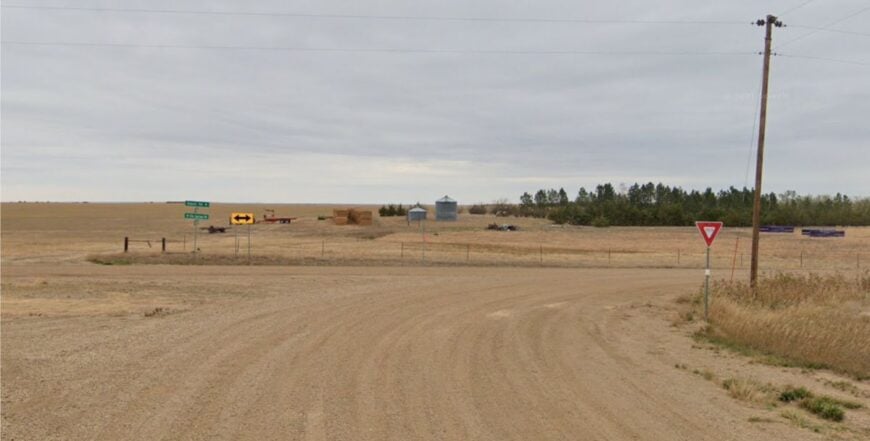
Elm Springs, home to fewer than 100 people, sits quietly in the wide-open prairie where wind and sky dominate. Its seclusion comes from being miles away from any larger towns, tucked into a stretch of land that feels empty and unbroken.
The vibe is frontier-like, with abandoned structures whispering of harder times and ranch homes standing stubbornly against the elements. Ranching defines life here, as it has for generations.
Visitors may find little in the way of attractions, but there’s beauty in the silence, the sunsets, and the endless fields of grass. Elm Springs is the kind of town where history lingers like dust on the wind.
Where is Elm Springs?

Elm Springs is in Meade County, about 45 miles northwest of Rapid City. It’s reached by long county roads that cut across the prairie.
With no major highways nearby, the journey itself feels remote and timeless. By the time you arrive, the quiet has already settled into your bones.
20. Nisland: A Farming Village by the River
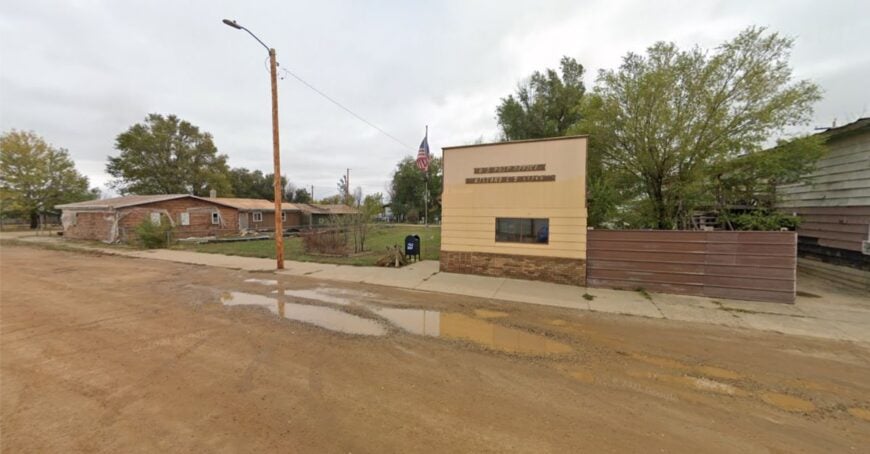
Nisland, with fewer than 300 residents, is tucked along the Belle Fourche River in Butte County. Its seclusion comes from being overshadowed by larger Black Hills towns like Belle Fourche, yet its fields stretch wide and quiet.
The vibe here is small-town agricultural, where fields of alfalfa and corn surround modest homes. Visitors might wander into the community park, fish along the river, or drive through the scenic farmland that wraps the village.
Farming dominates life, with irrigation shaping much of the valley. Nisland feels like a place that rests comfortably outside the world’s notice, anchored to its river and soil.
Where is Nisland?

Nisland is located in Butte County, about 12 miles east of Belle Fourche. It’s accessible via Highway 212, but feels tucked away once you drop into the river valley.
The drive is short but shifts quickly from bustle to stillness. Arriving, you’re greeted by green fields and the hush of open country.
19. Vale: Prairie Crossroads
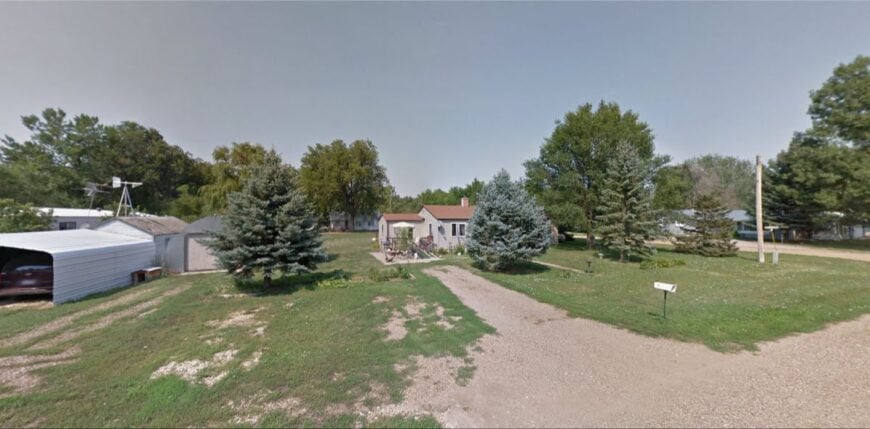
Vale is an unincorporated community with a few hundred residents scattered across wide ranchland. Its seclusion is marked by the long distances between homesteads and the endless prairie that surrounds it.
The town’s vibe is rugged and practical, a place where neighbors are few but friendships run deep. Ranching dominates, with cattle grazing on hills that roll softly toward the horizon.
Visitors may find a local rodeo, old grain bins, and trails leading into quiet countryside. At night, the sky opens wide, unbroken by city lights. Vale is the kind of place where you can hear the prairie wind louder than any engine.
Where is Vale?
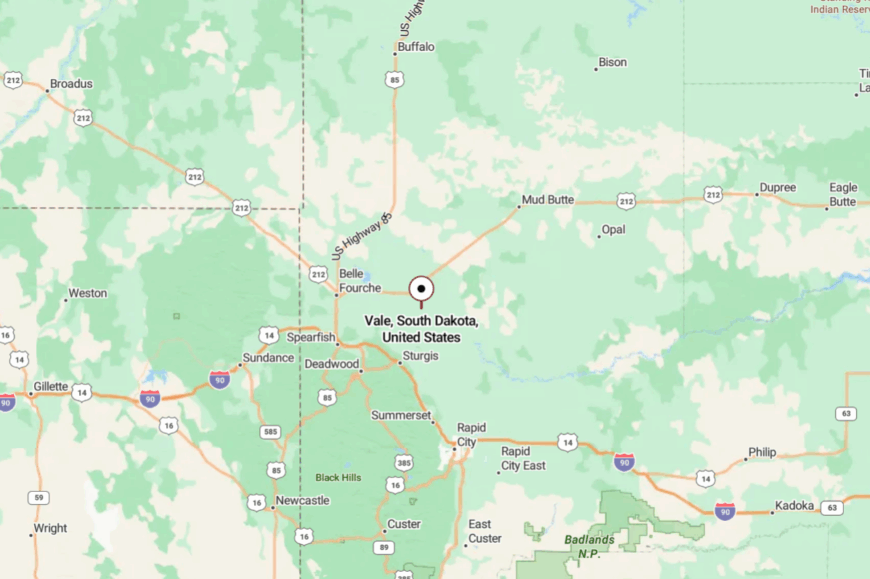
Vale lies in Butte County, northwest of Sturgis. It’s about 30 miles north of Interstate 90, reachable by State Highway 79 and county roads.
The journey takes you deeper into ranchland, where traffic thins to almost nothing. By the time you arrive, the sense of solitude is complete.
18. Opal: A Dot in the Grasslands
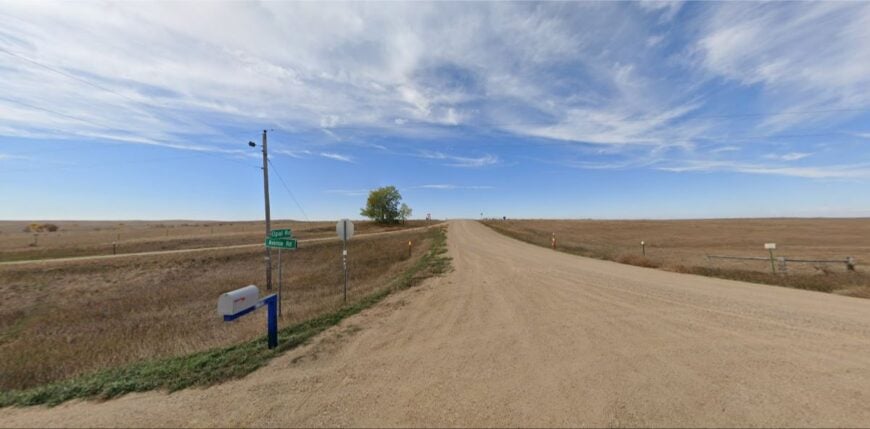
Opal, with barely a handful of residents, feels more like a whisper of a community than a town. Its seclusion is absolute—miles of gravel roads, endless grass, and very little development.
The vibe is stark and quiet, a place that seems suspended in time. Ranching is the only real livelihood, with families spread out across vast acreages. There’s little to do besides appreciate the rolling prairie, the wildlife, and the silence that’s rare in modern life.
Yet for those who find beauty in openness, Opal is hauntingly unforgettable. It’s the kind of place that reminds you just how big the sky can be.
Where is Opal?

Opal is located in Meade County, northeast of Faith. It’s about 100 miles from Rapid City, accessible only by gravel county roads.
The drive feels endless, with few signs of human habitation along the way. Arriving in Opal feels like discovering a secret stitched into the prairie.
17. Pringle: Small Stop Among the Pines
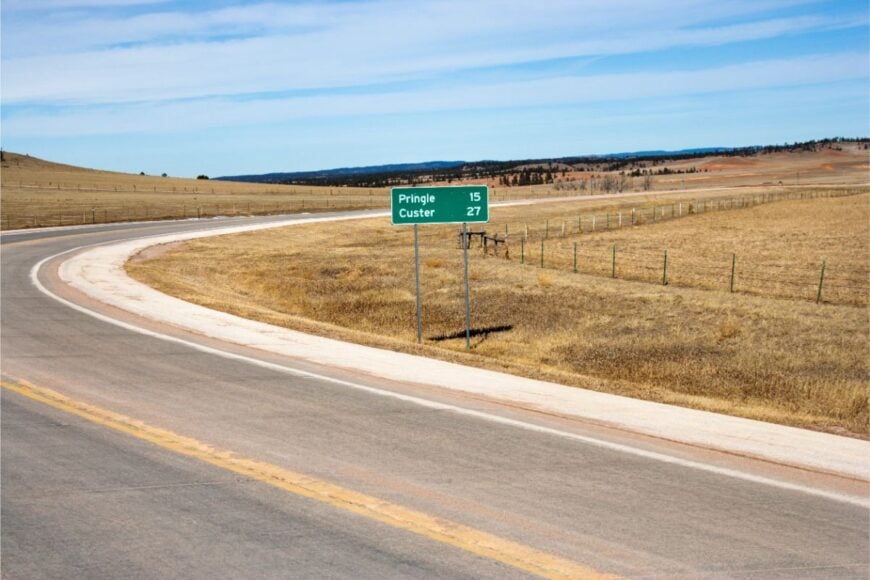
Pringle, with fewer than 150 people, is a quiet town in the southern Black Hills. Its seclusion comes from its small size and the forested ridges that shield it from busier highways.
The vibe is rustic and wooded, with cabins, small homes, and a sense of life tied to the hills. Outdoor enthusiasts use it as a gateway to the Mickelson Trail, which runs right through town for hiking and biking.
Locals are supported by ranching, tourism, and small businesses. Evenings here are filled with the scent of pine and the hush of forest breezes. Pringle feels like a town tucked neatly inside the hills’ embrace.
Where is Pringle?
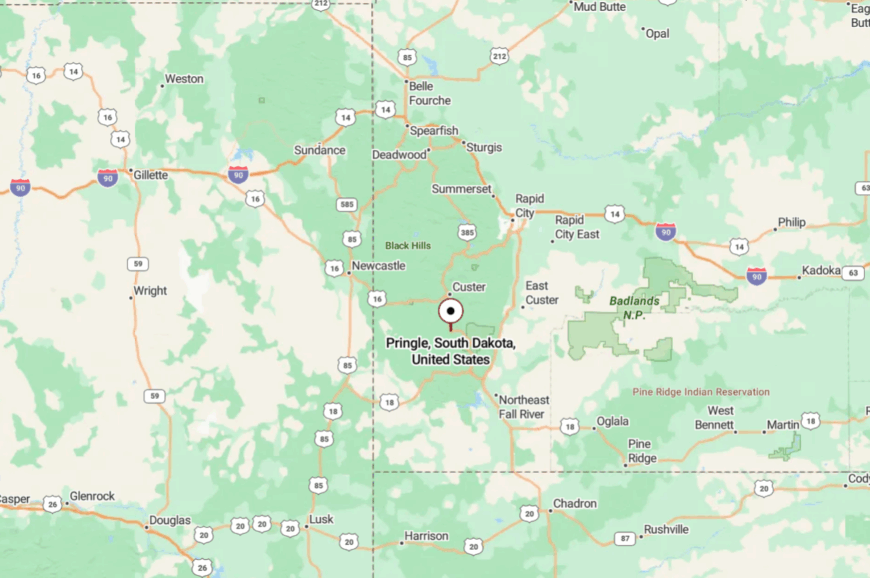
Pringle is located in Custer County, about 15 miles south of Custer. It’s reached via US Highway 385, a winding road through the Black Hills.
The drive shifts quickly from open prairie to dense forest. When you arrive, it feels like stepping into a pocket of peace hidden inside the pines.
16. Tuthill: Quiet Prairie Outpost
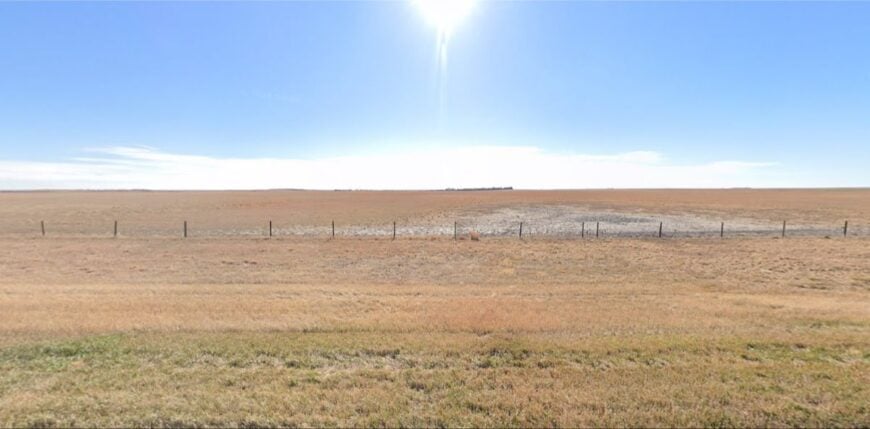
Tuthill is an unincorporated community where only a scattering of families live, surrounded by open grassland. Its seclusion is due to its location far from highways or larger towns, with only dirt roads connecting it to the world.
The vibe is stark, humble, and deeply tied to the land. Ranching is the only economy here, with cattle and horses moving across the wide prairies. Visitors will find little more than old buildings and prairie silence, but that silence is exactly its charm.
The stars at night are brilliant and undisturbed. Tuthill feels like a reminder of how people once lived with the land, not apart from it.
Where is Tuthill?

Tuthill is in Bennett County, in the southern reaches of western South Dakota. It’s about 30 miles east of Martin, accessible only by gravel roads.
The journey is long and sparse, passing through ranchland and prairie. Arriving there, you feel the edge-of-the-world quiet settle in immediately.
15. Camp Crook: A Frontier Echo
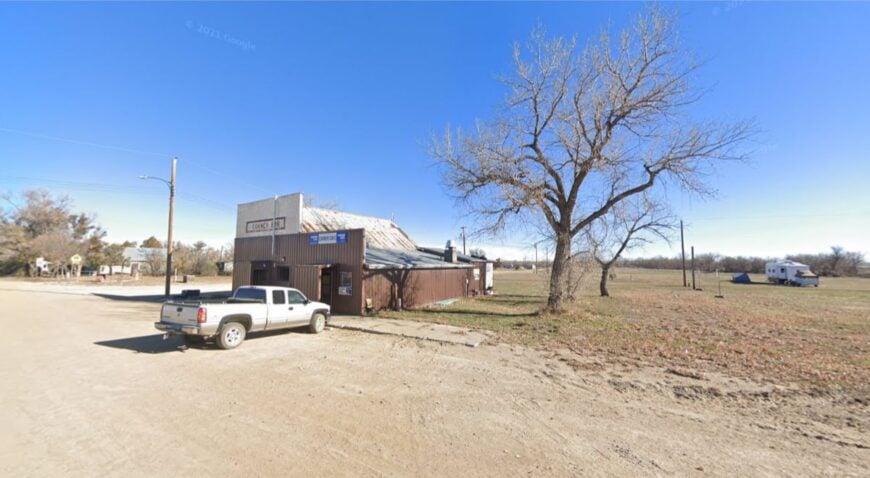
Camp Crook, with fewer than 100 people, rests along the Little Missouri River in the far northwest corner of South Dakota. Its seclusion is absolute—it’s closer to Montana and North Dakota towns than to its own state’s cities.
The vibe is frontier-like, with old wooden storefronts, quiet streets, and a history of ranching that still defines life today. Visitors might explore the nearby Custer National Forest, fish in the river, or stop at the few local establishments.
Ranching anchors the economy, with families here tied to the land for generations. It’s a community that feels like a living memory of the Old West. Camp Crook is the kind of place where solitude feels like heritage.
Where is Camp Crook?
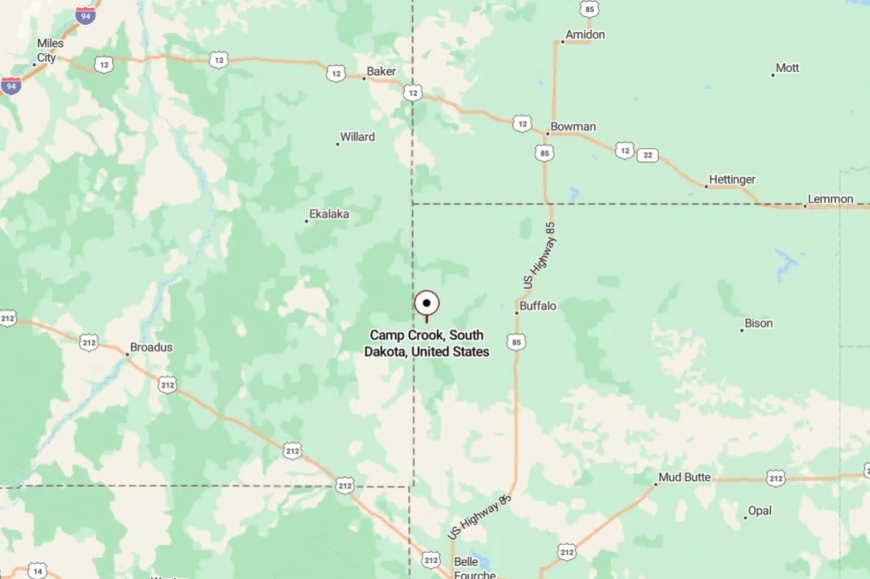
Camp Crook is in Harding County, tucked into the northwest corner of South Dakota. It’s about 50 miles from Buffalo, the county seat, and even farther from any larger city.
Access is via Highway 20, a lonely road that cuts across the prairie and into the valley. The isolation is so complete that arriving feels like stepping back into the 1800s.
14. Fruitdale: Quiet Among Orchards and Fields

Fruitdale, with fewer than 100 residents, sits quietly in Butte County where fertile ground meets the Belle Fourche River. Its seclusion comes from being overshadowed by larger neighbors, yet it retains its identity as a farming community.
The vibe is pastoral and homely, with orchards, fields, and quiet streets. Visitors can enjoy drives along the river valley, birdwatching, or exploring old farmsteads nearby. Agriculture is the lifeblood here, and life feels steady and seasonal.
Fruitdale is a town that doesn’t try to impress—it simply exists in harmony with its land. It’s the kind of place that feels like an anchor against the rush of time.
Where is Fruitdale?
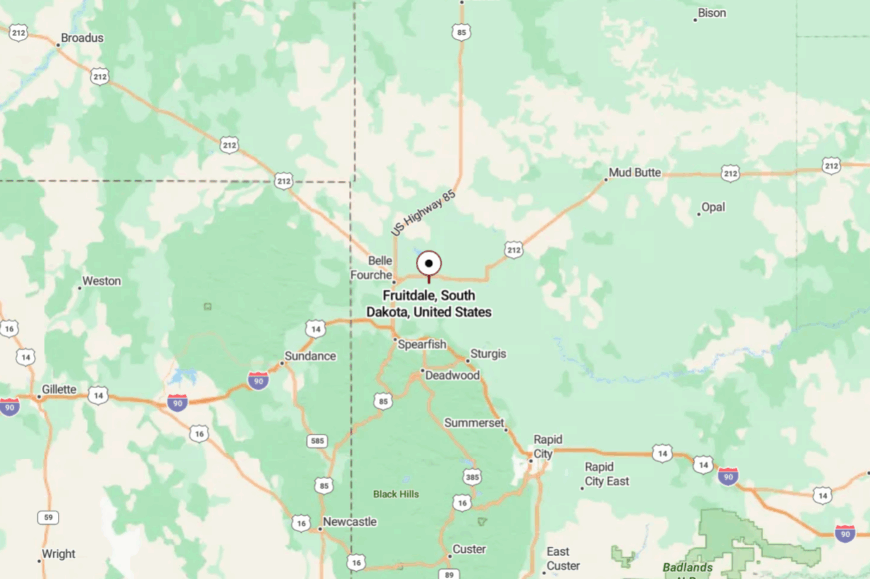
Fruitdale is located about 10 miles east of Belle Fourche in Butte County. It’s reached via Highway 212, but the town itself lies just off the main road.
The drive is short but takes you from bustle to quiet in an instant. Arriving in Fruitdale feels like settling into a softer rhythm.
13. Piedmont: A Tucked-Away Black Hills Foothold

Piedmont, with about 1,000 residents, rests quietly at the northern edge of the Black Hills where prairie gives way to pine. Its seclusion comes from being bypassed by faster travelers on I-90, who rarely turn off to discover its tucked-in streets.
The town vibe is neighborly and calm, with historic roots stretching back to its days as a railroad stop. Visitors can hike into the nearby Centennial Trail, explore Bear Butte State Park just to the north, or wander small local shops and cafés. Many locals balance ranching and commuting, yet the wooded hillsides surrounding Piedmont preserve a sense of privacy.
At night, the stars emerge above ridges that block out the wider world. Piedmont is the kind of place that feels hidden in plain sight, quietly waiting for those who slow down.
Where is Piedmont?
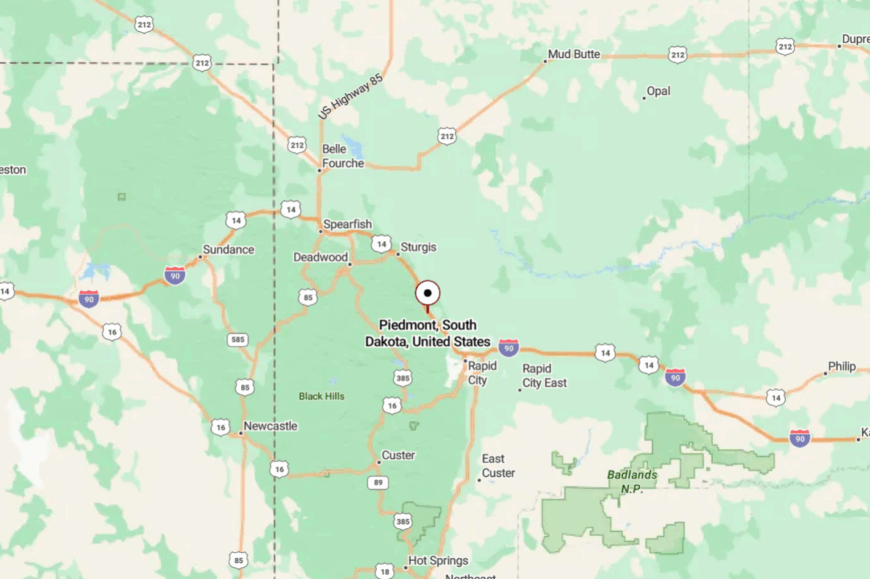
Piedmont is located in Meade County, about 15 miles northwest of Rapid City. It’s reached via Exit 46 off Interstate 90, but once you leave the highway, the forested hills quickly close in.
The road into town feels like a gentle slip from prairie into pine. By the time you arrive, the noise of the interstate has long since faded into silence.
12. Keystone: Hidden Beneath the Granite Faces
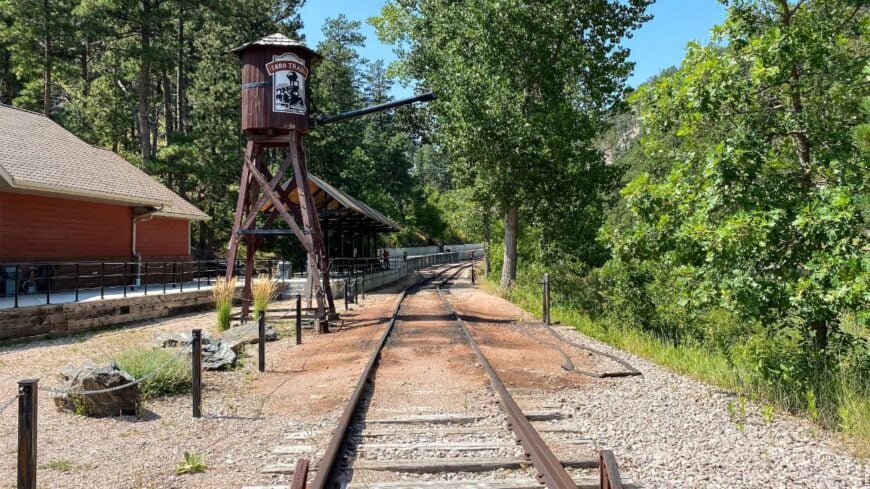
Though best known as the gateway to Mount Rushmore, Keystone remains a small, secluded town of about 350 people. Its seclusion comes from its location deep in a granite canyon, surrounded by towering hills and forests.
The vibe is rustic and historic, with old mining buildings, wooden storefronts, and winding streets. Visitors explore old gold mines, hike nearby trails, or visit the alpine slide when in season.
Tourism sustains the town, but its small year-round population keeps it intimate and quiet once the day-trippers leave. Keystone is a reminder that even near one of America’s busiest monuments, seclusion can still thrive.
Where is Keystone?
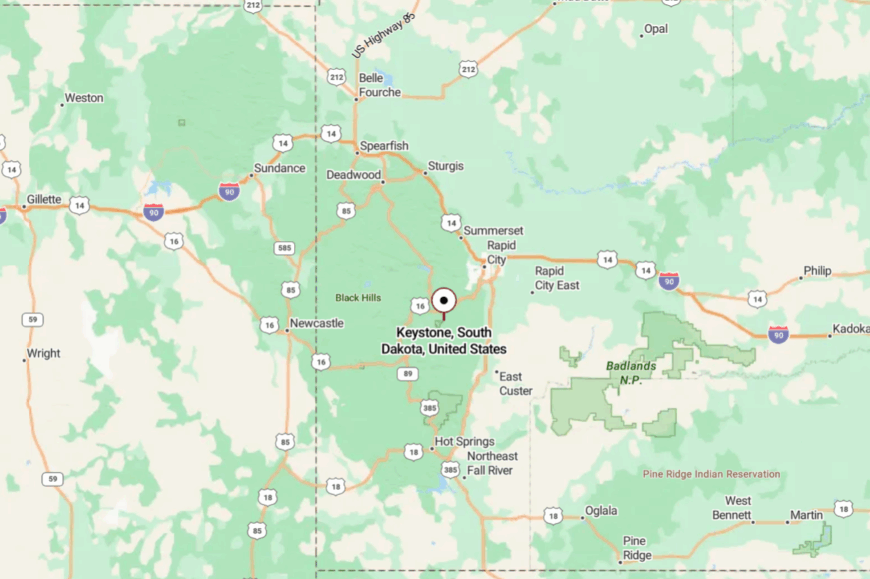
Keystone is in Pennington County, about 20 minutes southwest of Rapid City. It’s reached via US Highway 16A, a winding road that snakes through granite outcrops and pine forests.
The drive feels both dramatic and secluded, carrying you deeper into the hills. By the time you reach Keystone, you’re surrounded by forest and stone, hidden from the wider world.
11. Hill City: Quiet Heart of the Hills
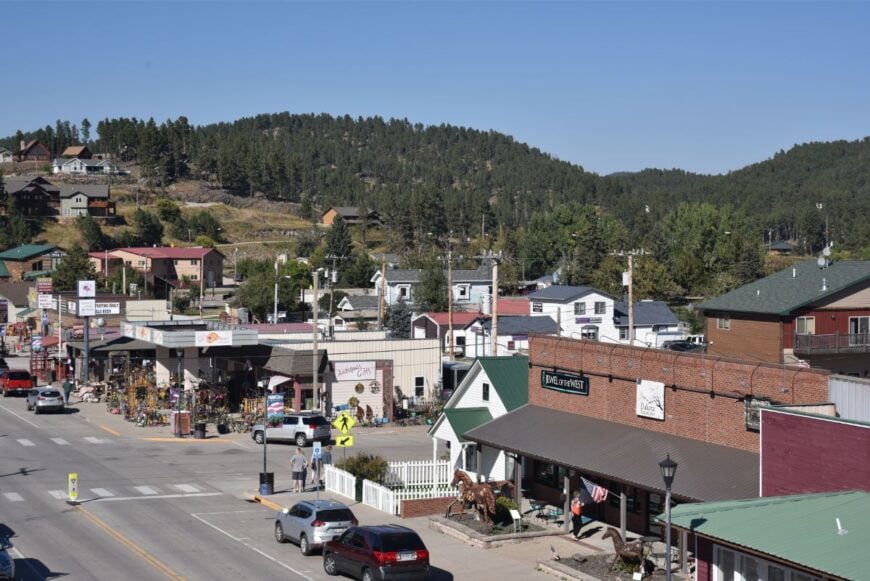
Hill City, with about 1,000 residents, is nestled among pine-covered ridges in the central Black Hills. Though it draws visitors in summer, its small size and forested setting keep it feeling secluded and intimate.
The vibe is artsy and historic, with galleries, wooden saloons, and remnants of its mining past. Visitors can ride the 1880 Train, hike the Mickelson Trail, or explore the surrounding lakes and peaks. Tourism is its mainstay, but the community retains its quiet pace once the crowds fade.
Evenings bring a hushed beauty, with pine-scented air drifting through town. Hill City feels like a village gently protected by the hills themselves.
Where is Hill City?
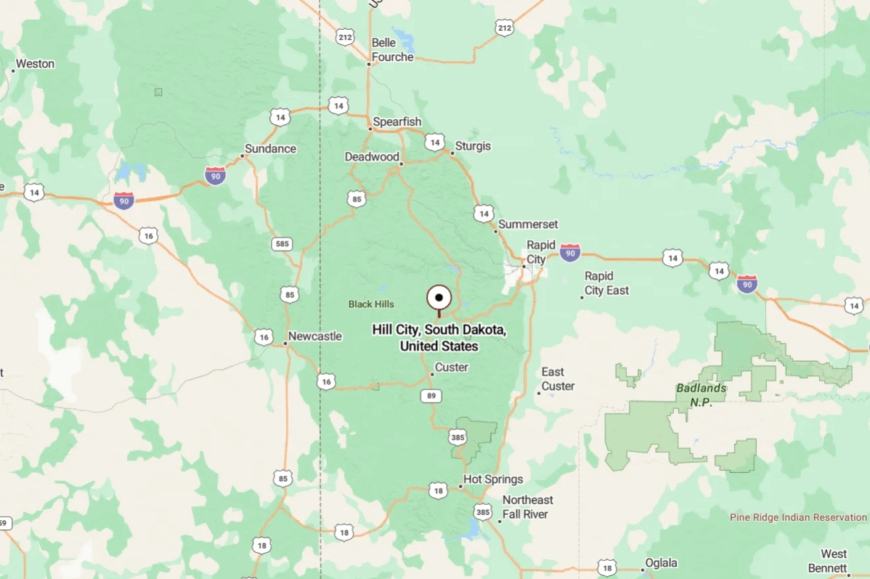
Hill City is in Pennington County, about 25 miles southwest of Rapid City. It’s accessible via US Highway 385, which winds through forest and granite cliffs.
The journey into town feels like slipping deeper into the Black Hills’ hidden heart. By the time you arrive, the quiet of the forest has already become part of you.
10. Owanka: Journey to Isolation

Owanka is truly a blink-and-you’ll-miss-it kind of place, with a population that barely reaches double digits. When I visited, I was struck by the quiet that envelops this unincorporated community nestled in the vast expanse of South Dakota’s prairie.
There’s not much in terms of industry here—most of the land is used for ranching, and the residents enjoy the simplicity that comes with such a lifestyle. The main draw for me is the sheer isolation; it’s the perfect spot to disconnect and immerse oneself in the open skies and rolling grasslands.
Without the distractions of urban life, you can truly appreciate the subtle beauty of the High Plains. Owanka’s seclusion is reinforced by its minimal development and the miles of unpaved roads that surround it, making it a haven for those seeking true solitude.
Where is Owanka?

Owanka is located in Pennington County, east of Rapid City, along what was once the route of the Chicago and North Western Railway. Its remote location on the vast plains is one of the reasons it’s so secluded—there are few major roads leading there, and it’s surrounded by miles of open land.
To get there, I took Highway 14/16 east from Rapid City and then ventured onto county roads that stretch through the prairie. The journey itself feels like a step back in time, and by the time you arrive in Owanka, you’ll understand why it’s considered one of the most isolated spots in Western South Dakota.
9. Fairburn: Hidden in the Hills
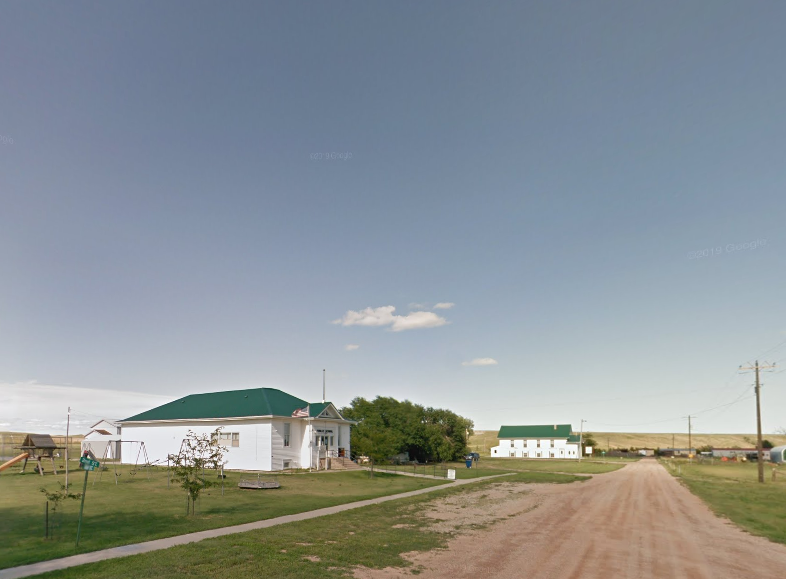
With a population hovering around 80 residents, Fairburn is one of those places that feels like a well-kept secret. Nestled in the foothills of the Black Hills, this tiny town offers an escape into nature’s embrace. I’ve enjoyed exploring the nearby Buffalo Gap National Grassland, where hiking and wildlife viewing are a tranquil delight.
There’s a sense of history here too—Fairburn was once a bustling stop during the gold rush days, and remnants of that era still whisper through the town. The seclusion comes from its tucked-away location amid the hills, far from the main tourist routes.
Agriculture and ranching are the primary industries, lending a peaceful, rural atmosphere that I find incredibly soothing.
Where is Fairburn?

Fairburn is situated in Custer County, south of Rapid City and east of Custer State Park. Its location off the beaten path, nestled among rolling hills and close to the Fairburn Agate Beds, contributes to its secluded feel.
To reach Fairburn, I took Highway 79 south from Rapid City and then turned onto county roads that weave through the scenic landscape. The journey through open rangeland and rugged hills makes it clear why Fairburn remains a quiet haven away from the hustle and bustle.
8. Wasta: Retreat into Simplicity
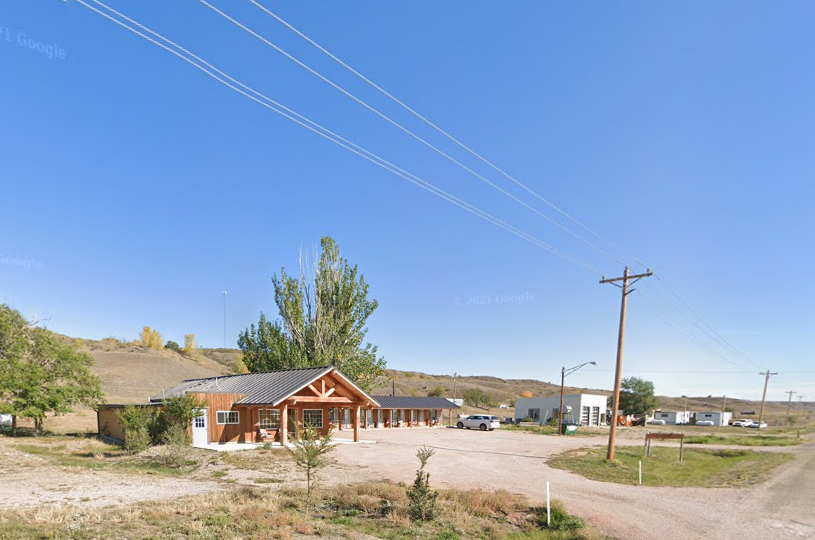
Wasta, with its modest population of around 75, is a place where simplicity takes center stage. I was charmed by the quiet streets and the feeling that time moves just a bit slower here. The town rests along the Cheyenne River, offering opportunities for fishing and enjoying the serene riverside environment.
Agriculture is the mainstay, with many residents engaged in farming and ranching. What makes Wasta secluded is its position off Interstate 90, making it easily bypassed by travelers heading to more prominent destinations.
It’s this very quality that provides a peaceful retreat, where large lot sizes and open spaces invite you to breathe deeply and unwind.
Where is Wasta?

Wasta is located in Pennington County, approximately 40 miles east of Rapid City along Interstate 90. Despite its proximity to the interstate, the town remains quiet and largely unnoticed by passing traffic. To get there, I simply exited off I-90 and found myself in a town that feels worlds away from the busy roadway.
The surrounding prairie and the vast sky create a sense of openness that underscores Wasta’s secluded nature.
7. Scenic: Quietude at the Edge of the Badlands
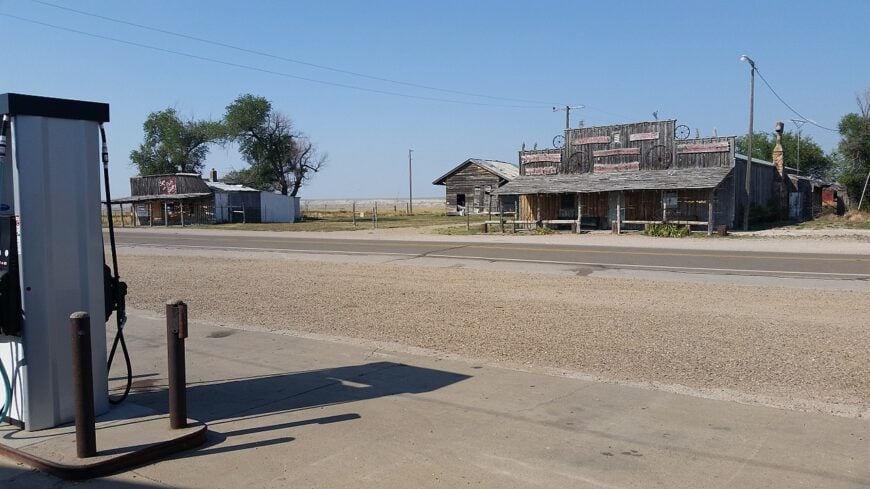
Scenic is a near-ghost town that truly lives up to its name, offering breathtaking views at the edge of the Badlands National Park. With a population that barely reaches a dozen, I found it to be a place where silence reigns and the rugged beauty of the Badlands takes center stage.
There’s a haunting charm to the abandoned buildings and the old structures that hint at a bygone era. While there aren’t traditional industries here, the stark landscape and open spaces provide a unique backdrop for photography and quiet exploration.
Scenic’s seclusion comes from both its tiny population and its location away from major roads, making it a perfect spot for those seeking solitude amidst dramatic scenery.
Where is Scenic?
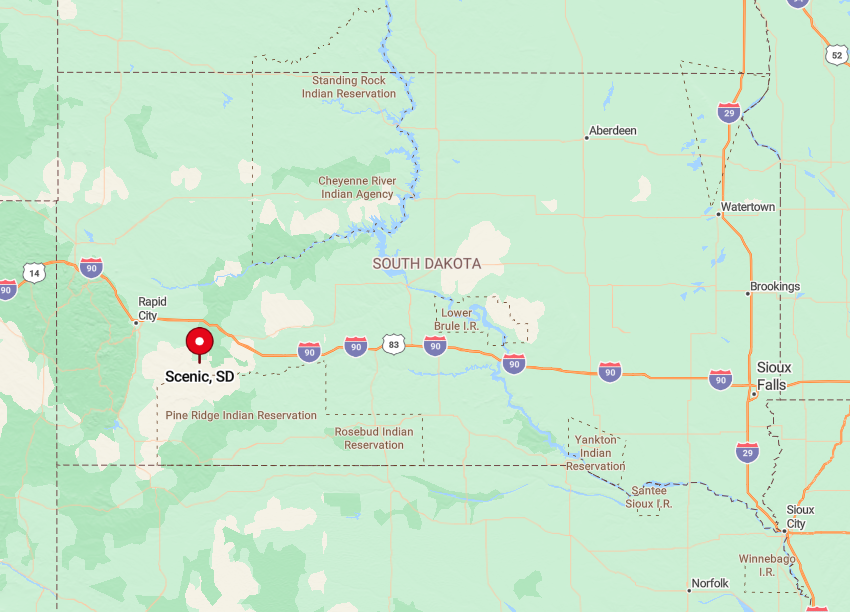
Scenic is situated in Pennington County, about 50 miles southeast of Rapid City along Highway 44. Its location on the outskirts of the Badlands contributes to its feeling of remoteness. I reached Scenic by following Highway 44 through miles of open prairie and rugged terrain, a journey that underscored just how isolated it is.
The vast stretches of undeveloped land and the minimal traffic make it clear why Scenic remains one of the most secluded spots in Western South Dakota.
6. Quinn: Peace on the Plains

Quinn is a small town where the horizon seems endless, and the peace of the plains comes alive. With a population of about 60 residents, I’ve found it to be a place where community ties are strong and the hustle of modern life feels distant.
The town offers a serene setting for those interested in bird watching or simply enjoying the expanse of the prairie. Agriculture is the heartbeat of Quinn, with many residents involved in farming and ranching.
Its seclusion is due to its remote location and the vast stretches of surrounding farmland, providing ample space and tranquility away from urbanization.
Where is Quinn?
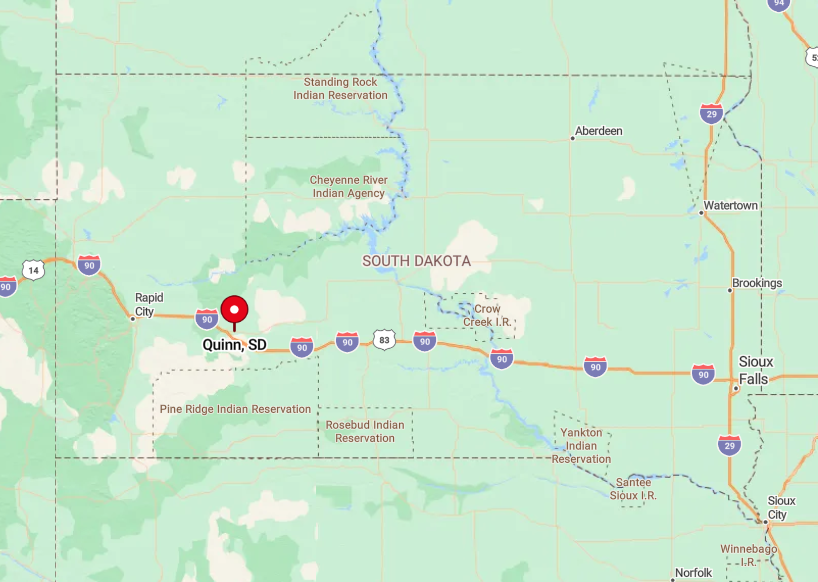
Quinn is located in Pennington County, just north of Interstate 90 and east of Wall. Its position on the open plains far from larger cities contributes to its secluded character. I took Interstate 90 to Exit 98 and followed a county road north to reach Quinn, passing through miles of agricultural land along the way.
The journey emphasizes the isolation, with few signs of civilization between the highway and the town, making Quinn a peaceful retreat into simplicity.
5. Red Shirt: Seclusion by the River

Red Shirt is a small community nestled near the Cheyenne River, with a population of around 40 residents. When I visited, I was captivated by the tranquility that comes from being so closely connected to nature.
The river offers opportunities for fishing and quiet reflection, and the surrounding landscape is rich with the history and culture of the Oglala Lakota people. There isn’t much in the way of industry, but the community thrives on its traditions and the natural resources of the land.
Red Shirt’s seclusion is enhanced by its remote location and the natural barriers created by the river and the rugged terrain, providing an intimate connection with nature that’s hard to find elsewhere.
Where is Red Shirt?

Red Shirt is located in Oglala Lakota County, on the northeastern edge of the Pine Ridge Indian Reservation. It’s situated near the confluence of the Cheyenne River and Red Shirt Table, a prominent landform in the Badlands.
To get there, I traveled south from Scenic on BIA Highway 41, navigating through a landscape that feels untouched by time. The remote roads and the lack of nearby towns contribute to Red Shirt’s isolated feel, making the journey just as memorable as the destination.
4. Oral: Oasis of Calm
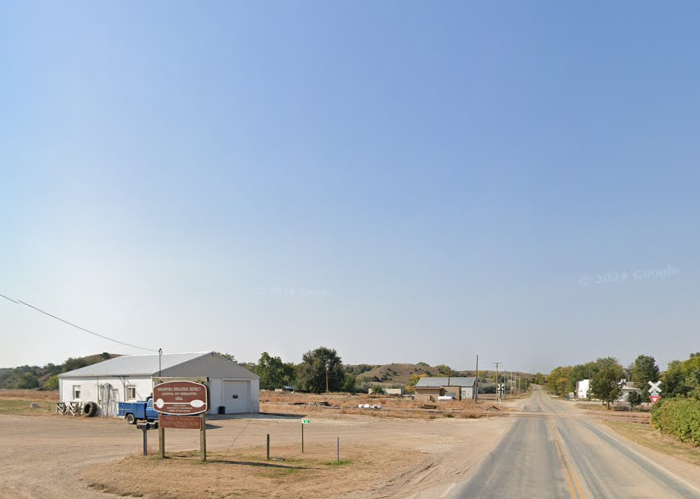
Oral is an unincorporated area that truly lives up to its name as an oasis of calm. With a sparse population, the community offers expansive acreage and a peaceful environment. I appreciated the wide-open spaces and the opportunity to disconnect from the hectic pace of daily life.
The area is primarily agricultural, with ranching and farming dominating the landscape. What makes Oral secluded is its distance from larger towns and the serenity provided by the surrounding natural beauty of South Dakota’s southern plains.
Where is Oral?
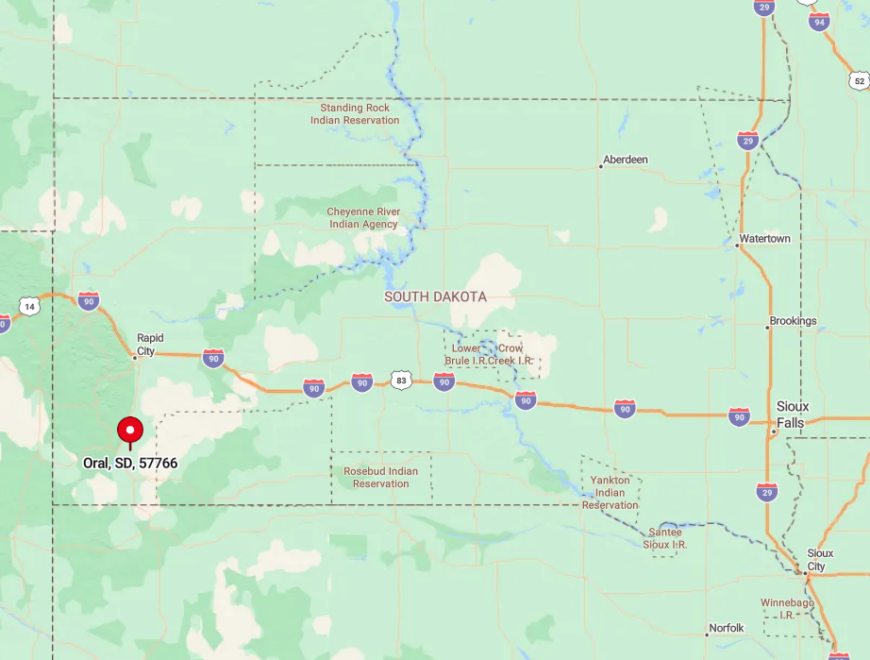
Oral is located in Fall River County, southeast of Hot Springs. To reach it, I took Highway 18 east from Hot Springs and then turned onto county roads that wind through the rural countryside. The lack of major highways and the sprawling nature of the land contribute to Oral’s secluded atmosphere.
The journey through rolling hills and open fields makes it clear why Oral is a perfect spot for embracing a quiet, rural lifestyle.
3. Buffalo Gap: Gateway to Solitude

Buffalo Gap, with its population of just over 130 residents, serves as a peaceful gateway to the southern Black Hills. I was drawn to its historic charm, with buildings that hint at its past as a frontier town.
Outdoor enthusiasts can enjoy nearby Wind Cave National Park and Custer State Park, making it a perfect base for exploring the area’s natural wonders. Ranching is prevalent here, and the community maintains a strong connection to the land.
The seclusion of Buffalo Gap comes from its small size and the surrounding undeveloped land, offering a serene environment ideal for those seeking privacy and a slower pace of life.
Where is Buffalo Gap?
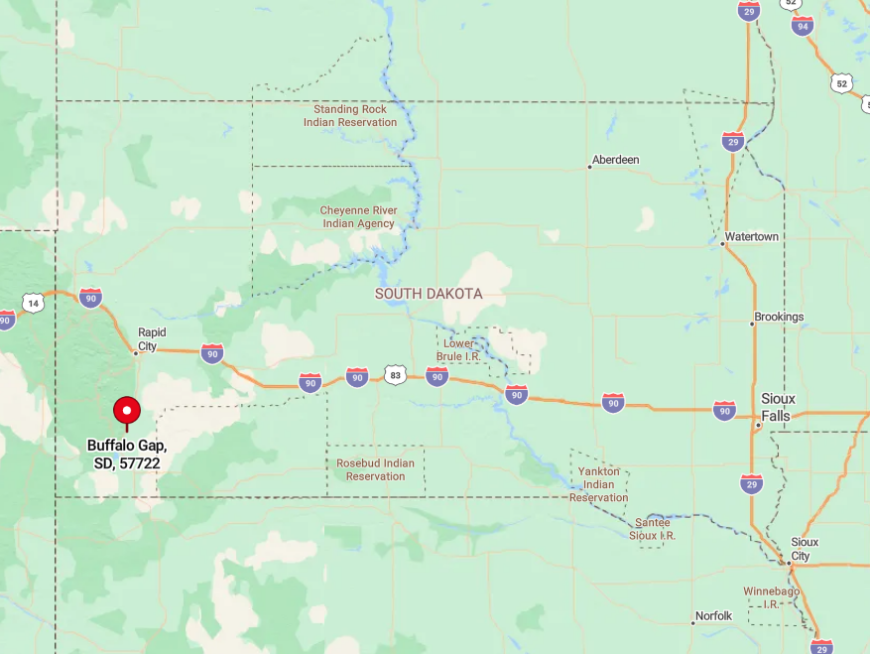
Buffalo Gap is located in Custer County, south of Rapid City and east of the Black Hills. It’s accessible via Highway 79, but its distance from larger cities and tourist hubs keeps it quiet. I drove south from Rapid City, enjoying the gradual change from cityscape to open prairie and rolling hills.
The town’s location amid vast ranchlands and near pristine natural areas contributes to its secluded charm, making it a hidden gem for those in search of solitude.
2. Oelrichs: Tranquil Prairie Living

Oelrichs is a quaint town of about 120 residents, where the prairie stretches as far as the eye can see. I found it to be a place where tranquility is part of daily life, and the community is close-knit and welcoming.
The town is surrounded by open grasslands, making it ideal for those who appreciate wide-open spaces and stunning sunsets. Agriculture is the main industry here, with farming and ranching shaping the local economy.
Oelrichs’ seclusion is due to its remote setting and the minimal development in the area, providing a peaceful retreat away from the bustle of city life.
Where is Oelrichs?

Located in Fall River County, Oelrichs sits along Highway 18 near the Nebraska border. To get there, I traveled south from Hot Springs, enjoying the expansive views of the prairie along the way. The town’s distance from larger urban centers and the vast surrounding landscapes make it feel wonderfully isolated.
The peaceful drive and the simplicity of the roads emphasize why Oelrichs is a haven for those seeking a tranquil lifestyle amid natural beauty.
1. Rochford: A Hidden Gem in the Black Hills

Rochford is perhaps one of the best-kept secrets in the Black Hills, with a population that might just be in the single digits. Hidden deep within dense forests and rolling hills, I’ve found Rochford to be a perfect place for those looking to truly get away.
The town boasts the historic Moonshine Gulch Saloon, a must-visit spot where locals and travelers alike share stories. Outdoor activities abound, with nearby trails for hiking, biking, and snowmobiling depending on the season.
There isn’t much in terms of industry—most of the livelihood here revolves around tourism and the occasional passing traveler. What makes Rochford secluded is not just its tiny population but its location, enveloped by the Black Hills National Forest and far from urban centers.
Where is Rochford?

Rochford is located in Pennington County, north of Hill City and southwest of Lead and Deadwood. To reach it, I meandered through winding forest roads, passing through breathtaking landscapes of pine-covered hills.
The town is accessed via Rochford Road, which itself is a scenic route that underscores the isolation of the area. Its position deep within the Black Hills, away from major highways and cities, makes Rochford a truly secluded haven for those seeking peace amid nature.

